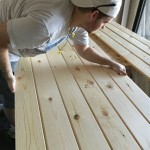Painting Murals on Interior Walls for Beginners
Transforming a plain interior wall into a vibrant, personalized mural is a rewarding DIY project that can dramatically enhance the aesthetic appeal of any space. Whether you're aiming for a whimsical scene, a calming landscape, or an abstract design, painting a mural can be a fun and creative endeavor. This article provides a step-by-step guide for beginners, offering tips and techniques to help you achieve impressive results.
1. Choosing the Right Wall and Design
The first step is selecting a suitable wall for your mural. Consider the size, shape, and existing decor of the room. Choosing a wall with minimal furniture and obstructions will provide a clear canvas for your artistic vision. Next, brainstorm design ideas. Consider the overall theme of the room, your personal preferences, and the style you wish to create. You might opt for a simple geometric pattern, a realistic landscape, or a stylized abstract design. Remember, the design should complement the existing decor and the overall mood you want to achieve.
Once you have a design in mind, sketch it out on paper or digitally. This will help you visualize the final product and make any necessary adjustments before committing to the wall. If you are a novice artist, consider starting with a simple design that uses basic shapes and colors. You can also find inspiration online or in design books. Remember, the design should be a genuine reflection of your style and interests.
2. Preparing the Wall and Gathering Supplies
Before you start painting, it's crucial to prepare the wall properly. This involves removing any existing wallpaper, cleaning the surface, and ensuring it's smooth and free of imperfections. If the wall has cracks or holes, fill them with spackle and sand them smooth. Finally, apply a primer to the wall to create a uniform base for the paint and enhance paint adhesion. The primer should be compatible with the type of paint you plan to use and the wall surface.
Gather all the necessary supplies for your mural. This includes paintbrushes in various sizes, rollers, masking tape, a pencil, a level, and a drop cloth to protect the floor. Choose high-quality acrylic paints for their versatility and ease of use. You might also consider using stencils, templates, or projector for more intricate designs. Ensure you have a well-ventilated workspace, good lighting, and a comfortable working area.
3. Transferring the Design and Starting to Paint
Using a pencil and a level, lightly sketch the main outlines of your design onto the prepared wall. You can use masking tape to create straight lines or to define specific areas within the design. If you're using a projector, project your design onto the wall and trace the outlines. Ensure that the outlines are visible but not overwhelming.
Start painting the background first. Choose a color that complements your overall design and the existing color scheme of the room. Use a roller for large areas and a brush for smaller sections, ensuring smooth and even coverage. Allow the background to dry completely before moving on to the next step.
4. Detailing and Refinement
After the background dries, begin adding details and refining your mural. Use a variety of brush sizes and techniques to create different textures and effects. Start with larger shapes and gradually move towards smaller details. For intricate details, consider using a ruler, stencils, or templates to achieve precise lines and shapes. Don't be afraid to experiment with different colors and techniques to create depth and dimension.
If you make a mistake, allow the paint to dry completely, then use a paint scraper or a damp cloth to remove the unwanted paint. You can also use a white paint pen to correct small imperfections. Don't be discouraged by mistakes; embrace them as part of the learning process.
5. Finishing Touches and Protection
Once your mural is complete, step back and assess the result. Consider adding finishing touches like outlining with a black marker or adding highlights with lighter shades. Allow the paint to dry completely before applying a sealant to protect your artwork from dirt, moisture, and fading. Choose a sealant that is compatible with your paint and the type of surface you've painted on.
Finally, admire your creation! A custom mural can transform any space into a personal oasis, reflecting your unique style and creativity. Remember, practice makes perfect. As you gain more experience, you can attempt more complex designs and techniques. Enjoy the process of creating your own personalized masterpiece.

Inspiring Wall Mural Painting Designs

Easy Diy Wall Mural Ideas One Brick At A Time

Inspiring Wall Mural Painting Designs

Easy Diy Wall Mural Ideas One Brick At A Time

What Is A Wall Mural Limitless Walls Design Blog
How To Paint A Mural Step By Guide Skillshare Blog

Inspiring Wall Mural Painting Designs

7 Easy Wall Mural Ideas Room Reveals Southern Yankee Diy
Interior Stylist Paints Nature Inspired Murals For Clients Photos
:max_bytes(150000):strip_icc()/250875494_604404903930925_4296208435685370961_n-80e82aed28ae445aaece1eabeae01d50.jpg?strip=all)
26 Colorful Wall Mural Ideas You Can Diy
Related Posts








